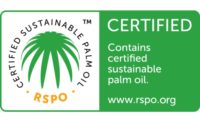As the palm oil industry makes efforts toward more sustainable practices, land management issues still affect the environment and communities surrounding palm oil production facilities. Despite these drawbacks, palm oil production continues to increase.
In 1976, global production of palm oil yielded 48 million metric tons, but over the last four decades, palm oil production has quadrupled, says Mark Zavodnyik, tropical oils trader at AAK. In 2014, production yielded 200 million metric tons.
Given its variety of uses, palm oil is currently the world’s biggest source of vegetable oil, accounting for 33 percent of all global production.
“There are many applications for palm oil,” Zavodnyik says. “In addition to chocolate and confectionery products, palm oil can be found in everything from bakery goods to personal care items, to candles.”
Palm oil use in food products, cosmetics and other everyday items makes it likely that demand for the flavorless oil will continue to rise. The U.S. Food and Drug Administration’s ban on partially hydrogenated oils (PHOs) contributes to greater interest in palm oil.
“When consumer concerns, and later FDA regulation, about trans fat led to some reformulation away from PHOs, palm oil became an attractive trans fat-free choice,” says Ivy Schlegel, research specialist from Greenpeace, an environmental advocacy group.
Confectionery products often contain palm oil because it has qualities similar to PHOs but does not have to be partially hydrogenated. When the FDA began regulating the use of trans fats, palm oil became a suitable alternative, especially for fillings and coatings.
Furthermore, palm oil has a high melting point, making it a more attractive option for the confectionery industry. Its cost-effectiveness and high yield also add to its appeal.
“Palm oil has many attractive qualities as a confectionery fat, and is often used as a cocoa butter alternative,” Schlegel says
Moreover, palm oil’s composition of fatty acids and triglycerides make it one of the most convenient vegetable fats to use in confectionery products.
“These attributes impart characteristic physical properties and helps us to fractionate the palm oil into palm olein, palm stearin and palm mid fractions,” says Ramesh Reddy, customer innovation manager at AAK.
The use of palm oil is on the rise because, like cocoa butter, it is a stable and natural fat source. A fat source like palm oil ensures that when products are packaged they maintain their quality for a longer amount of time on shelves.
“Current trends in vegetable oil consumption are shaped by consumers’ demand for healthier oils, government policy and regulation, technological innovation and sustainable sourcing,” Reddy says.
As demand continues to rise, developing countries in Southeast Asia, Central America, South America and Africa turn to palm oil production to stimulate economic growth. However, palm oil production has had negative consequences.
Poor land management contributes to deforestation, and as a result, has harmed native and indigenous communities, says Rodrigo Estrada Patiño, communications officer for Greenpeace.
Their food, medicinal plants and traditional, sacred lands have been destroyed, and communities surrounding palm oil production facilities have also experienced child abuse and labor exploitation.
Deforestation has also had an effect on the environment, particularly near palm oil production areas. The slash-and-burn method, which uses fire to clear the land, releases carbon into the atmosphere. Patiño pointed to severe forest fires last year in Indonesia, one of the main producers of palm oil.
The fires grew so large that the resulting haze reached neighboring countries in continental Southeast Asia and other islands. During this period Indonesia emitted more carbon into the atmosphere than other industrialized nations including the United States and China, Patiño says.
But there is hope. The Roundtable on Sustainable Palm Oil (RSPO), founded in 2003, is a voluntary organization where palm oil producers and traders make Southeast Asia’s palm oil supply chain more sustainable. It addresses the environmental and social problems relating to the palm oil industry.
“The RSPO’s vision is to transform the industry to make sustainable palm oil the norm,” Zavodnyik says. “The RSPO created a set of global principles and criteria, which allow for palm oil to be certified as sustainable, and for all stakeholders in the supply chain to handle certified oil.”
RSPO currently has more than 2,000 members including plantations, refiners and end-users.
Recent efforts also have been made to improve land management practices. A few companies have committed to using sustainable processes and ask palm oil suppliers to practice sustainably. This includes avoiding forests and surrounding communities to not cause conflict.
“We’re talking about traders and the actual people that grow palm oil in the ground,” Patiño says. “Those are the people that need to step up and make a change.”
The High Carbon Stock Approach (HCSA) is one possible direction for palm oil production plants. HCSA protects peatland areas and forests with strong biodiversity that contain many carbon emissions.
Furthermore, groups such as the Palm Oil Innovation Group charter lay out a framework for companies to stop deforestation practices and peatland conversion. It also has palm oil production plants commit to ceasing land, labor and human rights violations.
“The solution is to work together — industry, government and society so we can attain solutions together,” Patiño says.




